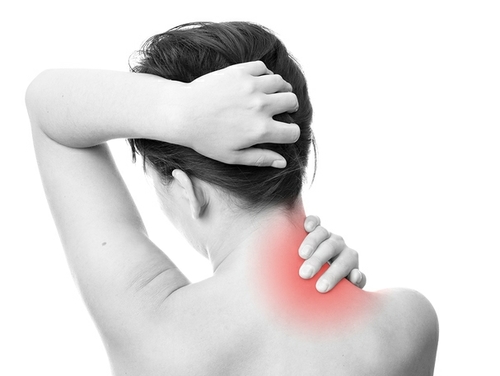Bulging Disc in Neck
A bulging disc in the neck occurs when a disc is damaged, protrudes into, and narrows the space in the cervical spine. This disc protrusion is caused by the surrounding vertebrae squeezing the disc and causing it to bulge out into the spinal column. Fixing a bulging disc in the neck may require surgery if causing pain chronically.
Overview
When most people hear the words “bulging disc” they generally think “back” not “neck.” However, the cervical spine, or neck, has the same anatomy as the rest of the spine – including discs. Learn more about the causes, symptoms, and treatment for a bulging disc in the neck below.
Anatomy
The cervical spine contains 7 vertebrae. The first two vertebrae, C1 and C2, are specialized and C3-C7 are more classic vertebrae that have a body, pedicles, laminae, spinous processes, and facet joints. The skull rests upon C1 and articulates in a pivot joint with C2, giving the skull a great deal of mobility. There are transverse foramina in each vertebra so the vertebral arteries can supply blood to the brain.
What Is a Bulging Disc in the Neck?
A bulging disc in the neck occurs when a disc in the cervical (upper spine or neck) is damaged and weakened to the point that it protrudes outward. While some cervical bulging discs go unnoticed and are asymptomatic, others result in symptoms that range from mild to severe and debilitating. When the spinal cord or nearby nerve roots are compressed, symptoms arise in various areas of the body.
Causes of a Bulging Disc in the Neck
A bulging disc typically develops due to continual motions gradually deteriorating or wearing down the joints between the vertebrae, causing them to put pressure on the discs. This is especially the case in the cervical spine because the neck moves more than the thoracic and lumbar regions of the spine. The vertebrae and discs in the neck support the head and neck and facilitate their movement. This continual movement may cause the vertebrae to deteriorate and a bulging disc in the neck will develop over time.
Factors that can cause or exacerbate a bulging disc in the neck include:
- Strain or injury
- Smoking or excessive alcohol consumption
- Improper lifting techniques
- Poor posture
- Inactivity
- Repetitive actions such as bending or twisting
Symptoms of a Bulging Disc in the Neck
Nerve root compression symptoms at the cervical level may include:
- Pain, tingling, numbness, and weakness in the neck, shoulders, arms, hands, and fingers
- Difficulty walking (in case of myelopathy)
- Feeling of heaviness in the legs (in case of myelopathy)
- Loss of fine motor skills in the fingers
- Headache, sleepiness, and brain fog
If you have one or a combination of the symptoms above, consult a physician or spine care specialist about treatments that will help relieve the pain and symptoms caused by a bulging disc.
Diagnosing a Bulging Disc in the Neck
As mentioned above, not every bulging disc in the neck causes symptoms. Many times, a patient will find out they have a bulging disc after an x-ray for an unrelated reason. But usually, it is the symptoms that cause the patient to visit their doctor. The doctor will then review the patient’s medical history, perform a physical and neurological exam, and order diagnostic imaging tests such as an x-ray, MRI, or CT scan.
Treatment for a Bulging Disc in the Neck
Often, patients choose conventional, non-surgical treatment options at first. Each patient is different, and not all treatment options work on every patient. It may take some trial and error to determine the combination of treatment options that provide pain relief and alleviate the symptoms.
Non-Surgical Treatment
Some patients find relief through treatments such as:
- Anti-inflammatory medication to reduce swelling
- Pain medication and muscle relaxants
- Exercises to improve posture and stabilize the spine
- Ergonomic changes to give the neck and back more support while sitting
- Physical therapy
Surgical Treatment
Surgery may be necessary to fix a bulging disc in the neck if the pain and other symptoms get progressively worse and conventional, non-surgical treatment options have failed to provide relief. Decompression surgery may be required if the bulging disc is compressing the spinal cord or nerve roots.
The Bonati Spine Institute offers an array of procedures to treat bulging discs in the neck. These procedures may include:
Prevention & Self-Care
While aging is inevitable, lifestyle changes can help prevent or delay the onset of cervical disc disease.
- Practice good posture and body mechanics
- Maintain a healthy body weight
- Exercise regularly
- Don’t smoke
To see The Bonati Procedures results with a bulging disc, check out our patient’s testimonial videos by clicking here.

